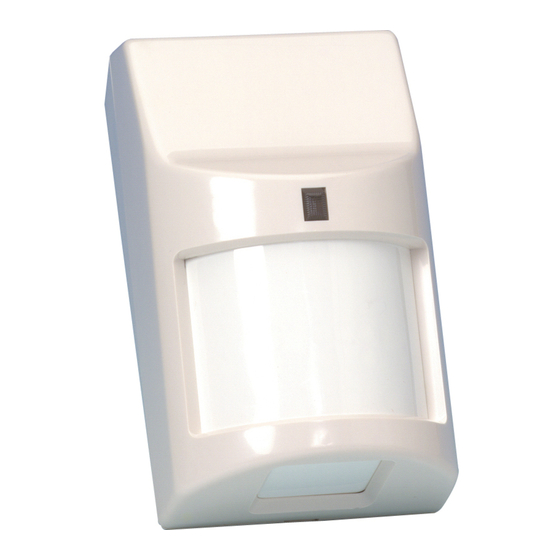ADEMCO 998PI Instructions d'installation - Page 3
Parcourez en ligne ou téléchargez le pdf Instructions d'installation pour {nom_de_la_catégorie} ADEMCO 998PI. ADEMCO 998PI 4 pages. Passive infrared motion detectors

switch handle up or down.
Standard Pulse Count: This is the recommended setting for maxi-
mum false alarm immunity. It tolerates environment extremes on this
setting.
Note: Standard Pulse Count is recommended for pet immune
applications.
Intermediate Pulse Count: This is the recommended setting for any
location where an intruder is expected to cover only a small portion of
the protected area. It tolerates normal environments on this setting.
Note: NOT recommended for pet immune applications.
TEST PROCEDURES
Important: Two-minute warm-up time is required after applying
power. Testing should be conducted with the protected area cleared of
all people. Disarm the protective systemÕs control during the test pro-
cedure to prevent reporting of unwanted alarms.
1. Remove front cover and set DIP switch #2 (Pulse Count) to the set-
ting which will be used for this detector in the installation. The
LED must be enabled at this time (DIP switch #1 down).
2. Replace front cover and walk through protective zones, observing
that the detectorÕs LED lights whenever motion is detected (the
LED serves as a Walk-Test indicator during this procedure).
The absolute range of all PIR units is subject to variation because of dif-
ferent types of clothing, backgrounds and ambient temperature. For this
reason, ensure that the most likely intruder routes are well within the
PIRÕs protective zones and that Walk-Testing is carried out along these
routes.
After the Walk-Test is complete, the LED may be disabled (DIP switch
#1 UP).
MAINTAINING PROPER OPERATION
In order to maintain the detector in proper working condition, it is
important that the user observe the following.
1. Power should be provided at all times. Loss of power to the unit
will result in the alarm contacts reverting to an alarm state. The
unitÕs DC source should have standby power available for at least 4
hours of operation during emergencies.
2. Units should never be re-aimed or relocated without the advice or
assistance of the alarm service company.
3. The physical surroundings of the protected area should not be
changed. If furniture or stock is moved, or air conditioning or addi-
tional heating is installed, the system may have to be readjusted
by the alarm service company.
4. Walk-Tests should be conducted frequently (at least weekly) to con-
firm continued proper coverage by each detector.
TROUBLESHOOTING
INTERMITTENT ALARM (LED OPERATIVE)
A. Rapid temperature change. Check for electric or gas heaters, open
flames, electric arcs, etc.
Remedy: Locate source and reposition detector.
B. Drafts causing drapes, light fixtures, display material to move.
Remedy: Eliminate source of motion.
INTERMITTENT OR CONTINUOUS ALARM
A. DC voltage supplied to detector is inadequate or intermittent, or
polarity is reversed.
Remedy: Ensure that polarity is corrected, adequate voltage is
supplied, wiring is intact (no opens/shorts), and connections secure.
B. Protective loop is interrupted (open).
Remedy: Determine whether interruption is in protective loop
wiring or at detectorÕs alarm relay contacts. Disconnect protective
loop at detector relay contact terminals. Check continuity across
terminals. If absent (and proper voltage is supplied to the detector),
return unit for replacement. If present, check protective loop
wiring.
LED INOPERATIVE
A. LED DIP switch #1 in UP position.
Remedy: Set DIP switch #1 in DOWN position.
B. LED malfunction.
Remedy: Check for broken/shorted leads. Return unit for replacement.
DETECTION AREA CHANGES
A. Repositioned furniture or equipment in the protected area.
Remedy: Caution customer about layout changes. Reposition
detector.
B. Mounting surface is unstable. A few degrees of vertical shift can
change range substantially.
Remedy: Mount on secure surface.
PANEL INDICATES CONTINUOUS FAULT IN ZONE OF PROTECTION
CONTAINING PIRs
(PIR's alarm LED not lit)
Too many detectors being used in the zone. Each detector adds 15
ohms of series resistance and the zoneÕs allowable loop resistance is
being exceeded.
Remedy: Reduce the number of detectors used in the zone until the
series resistance is within the allowable loop resistance permitted by
the control.
Table 1. PCB ADJUSTMENT FOR PET IMMUNE LENS
Use this position for 6.5ft - 7ft (2.0m - 2.1m) mounting height.
Use this position for 7-7.5ft (2.3m) mounting height.
ÐÐÐÐÐÐ- Vertical Pattern Setting ÐÐÐÐÐÐ
Note: When setting angle, eyesight should be directly in front
of scale to avoid parallax errors.
TO THE INSTALLER
Regular maintenance and inspection (at least annually) by
the installer and frequent testing by the user are vital to con-
tinuous satisfactory operation of any alarm system.
The installer should assume the responsibility of developing
and offering a regular maintenance program to the user, as
well as acquainting the user with the proper operation and
limitations of the alarm system and its component parts.
Recommendations must be included for a specific program
of frequent testing (at least weekly) to ensure the system's
operation at all times.
+5
0
- 5
-10
-15
-20
